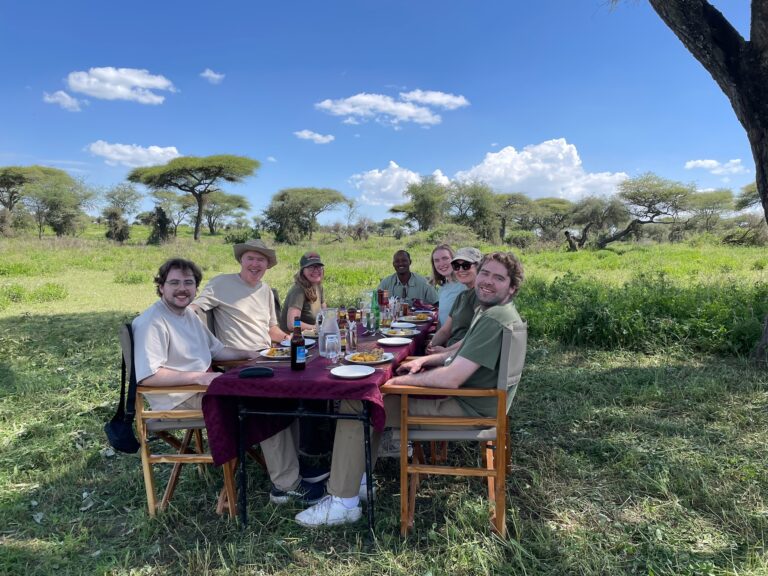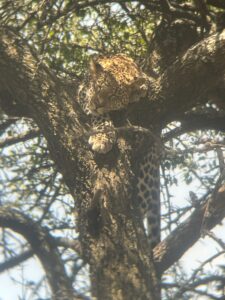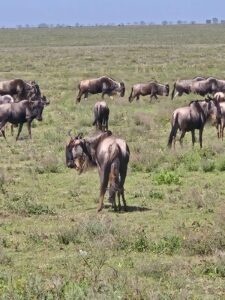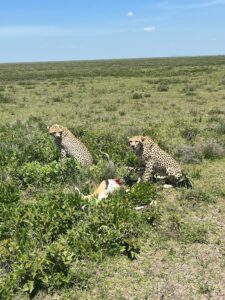By Kelly McBride, Safari Specialist for The Wild Source
Most wildlife enthusiasts are familiar with Tanzania’s Great Migration where roughly 1.5 million wildebeest and 500 thousand zebra and other ungulates journey across Tanzania’s Serengeti National Park and into Kenya’s Masai Mara. In fact, if you ask people to describe the migration most will likely tell you that it involves brave wildebeest crossing a river full of hungry crocodiles waiting to eat them. And of course they would be right to an extent as that is certainly one of the most iconic representations of the migration. But that is only part of the continuous cycle that is the life of a wildebeest. And lucky for them because if they had to spend every day moving back and forth across a predator infested body of water they may very well just give up and stay put. That would have made my recent trip to Tanzania very different.

This past January I traveled to Tanzania specifically to see the migration far from the iconic river crossings. Instead I visited the wide open expanses of the Ndutu area of the Southern Serengeti and Ngorongoro Conservation Area. I was there with my brother and his family who were on their first safari and our goal was to witness the mega herds of wildebeest during their calving season. From January through March their synchronized births result in thousands of new lives every day and upwards of 500,000 calves over the course of a few weeks. This is its own spectacle and it did not disappoint.
When we arrived at the short grass plains, after traveling from the highlands above Ngorongoro Crater, I was amazed at how flat the land became and how distant the horizon seemed. I strained my eyes to identify the woodland landscape where our tented camp, Njozi, was situated. It felt strange being able to see so far and I lost sense of time and distance. It turns out I have poor vision and it was only another 15 minutes or so that the line of trees defining this oasis came into clear view along with it the wildlife that was calling it home.

Within minutes of our arrival, a wildebeest stampede crossed in front of our vehicle. To me it was pure chaos, but our expert guide, Moinga, knew exactly how to navigate us into a great viewing spot. Before we knew it, a lioness burst out of the bushes and toppled a young wildebeest only to land in another dense bush out of sight, making it seem like it never happened. What a welcome to Ndutu!

These were the first of thousands upon thousands of wildebeest we would see over the next 4 days, growing exponentially each day. You’d think that it would be easy to spot 500 thousand wildebeest giving birth but anyone who has been there can attest to its difficulties. The mothers are experts at sticking with the herd throughout their delivery, despite the near constant movement, so it’s easy to lose them in the crowd. Cue Moinga, our super safari guide, who managed to spot a mother in labor with the tiniest little hoofs emerging. He then managed to keep her in his binos while maintaining a comfortable distance to avoid alarming her. For more than an hour the 6 of us repeatedly asked each other and Moinga, “Where is she? Do you see her? Is it that one? No? That one? No? Where is she now?” Until, eventually, we all found her and were able to hold our focus on her long enough to watch her final push. Welcome to the world little wildebeest! We all cheered and patted ourselves (and Moinga of course) on the back for being a part of what felt like an endurance sport. And then we watched quietly captivated as the calf fumbled and found its footing and within 3 minutes joined the herd in their procession.

That one memory would have been enough to justify the entire trip but the calving season kept delivering incredible wildlife sightings one after the next. Cheetah hunting, nomadic lions on the move, hippo in Lake Ndutu, hyena scavenging wildebeest placenta, leopard napping in trees, vervet monkeys playing hide and seek, giraffe being impressively tall, adorable marsh owls, zebra with unusual stripes, vultures cleaning carcasses in minutes, several serval, huge herds of eland, tortoises that I mistook for rocks more than once and many, many more.
It’s fascinating to think that the brave wildebeest crossing the Mara River in the Northern Serengeti started as wobbly calves in the Southern Serengeti like we saw in Ndutu. Their life cycle starts and ends somewhere along this continuous circuit which means every day in the Serengeti is actually a migration season. What other interesting behaviors are they exhibiting on their journey in between these two locations beyond the river crossings and the calving, I wonder? Perhaps that is my next trip.